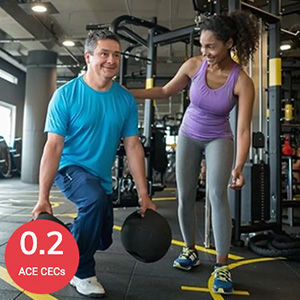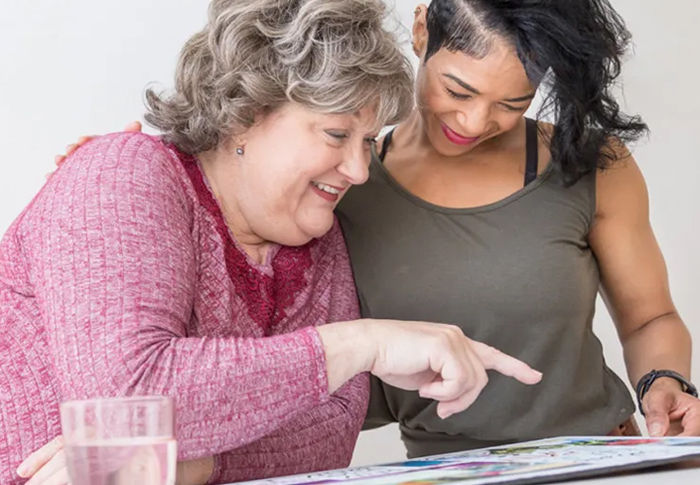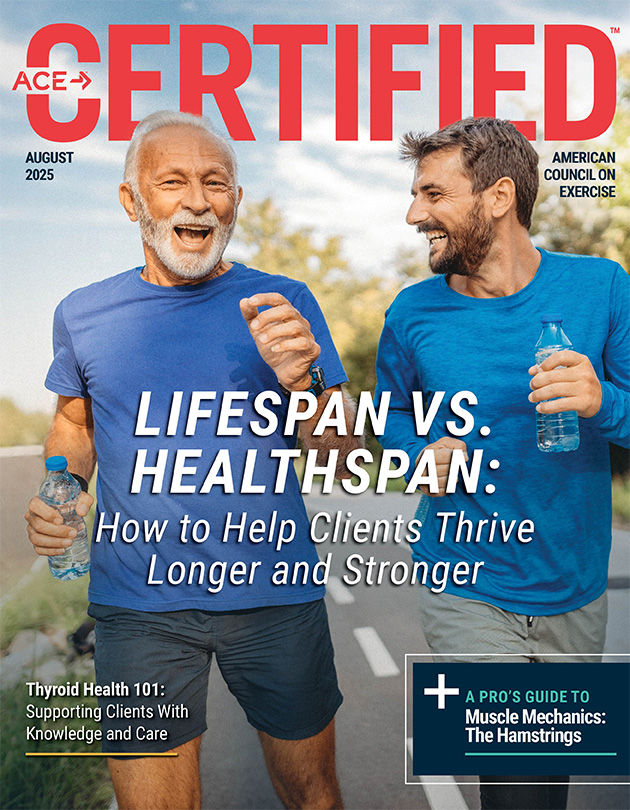
Longevity is among the latest and most ubiquitous buzzwords in the fitness industry. In fact, ACE has published several blogs and articles in recent months to help health coaches and exercise professionals like you navigate this complex topic, from understanding key definitions to knowing how to talk to clients about aging with positivity.
This article aims to answer three specific questions:
- What has the research revealed in terms of trainable elements of physical fitness that correlate to a longer life and better function as we age?
- How is exercising for longevity or to extend one’s healthspan different from exercising for general health?
- How can exercise professionals approach program and class design in a way that helps their clients or participants pursue healthspan-related goals without having to overhaul what they are already doing?
Continuing Education Opportunities
If you are interested in learning more about longevity and healthspan, check out these courses:

Achieving Longevity through Movement (worth 0.5 ACE CECs): The five modules that make up this course provide impactful movement strategies to motivate clients leading a sedentary lifestyle to be more active and will help you understand how different exercise modalities, including strength training, yoga and Pilates, contribute to longevity.

Longevity-Focused Program Design (worth 0.2 ACE CECs): This course offers an evidence-based framework for longevity training, combining strength, power, mobility and recovery.
Shifting Perspectives
Before attempting to answer those questions, let’s first explore how the fitness industry’s perspective has shifted from a focus on longevity to a focus on healthspan. Strictly speaking, longevity is defined as the number of years a person lives. So, “exercising for longevity” traditionally involved working with older adults to address health issues or functional concerns that may limit their lifespan.
However, the term “longevity” has evolved in some areas of the industry to also include healthspan, or the number of years lived in good health. As explained by Jan Schroeder, PhD, professor in the Department of Kinesiology at Long Beach State University, in a recent Q&A, “This definition emphasizes not only the length of life but also the quality of life during those years.”
Avery Faigenbaum, EdD, FACSM, FNSCA, professor in the department of health and exercise science at The College of New Jersey and a member of the ACE Scientific Advisory Panel, adds another element to this conversation with his research into strengthspan, which emphasizes quality of life in terms of physical strength and function and the ability to perform everyday tasks independently and recreational activities proficiently as people age.
This shift from aging more to aging well likely reflects a growing understanding among fitness consumers of the benefits of physical activity and the decades-long shift driven by baby boomers to live more active lifestyles as they grow older.
Question 1: What has the research revealed in terms of trainable elements of physical fitness that correlate to a longer life and better function as we age?
There are a number of ways that exercise expands healthspan, including improvements in insulin sensitivity, contractility of the heart muscle, and neuroplasticity and neurogenesis in the brain, in addition to its anti-obesity and anti-inflammatory effects. Research has also revealed correlations between several specific elements of physical fitness and longevity/healthspan, which are outlined below.
Correlation vs. Causation
It’s important to highlight the difference between correlation and causation. Correlation simply means that there is a statistical relationship between two variables, while causation means that a change in one variable directly causes a shift in the other. Consider these health-related examples:
- Correlation: People who sleep less tend to weigh more. This doesn’t mean that lack of sleep causes weight gain, but rather that there is a statistical connection between the two. The actual cause varies by individual and may be related to such factors as increased stress levels, unhealthy eating habits or an overall sedentary lifestyle—all of which can contribute to both poor sleep and weight gain.
- Causation: Smoking causes lung cancer. In this case, research has proven that chemicals in cigarettes directly damage lung tissue and cause cancer.
Grip Strength. As explained in a recent CERTIFIED article, there is evidence of the correlation between hand grip strength (HGS) and healthspan, including a “significant relationship” between HGS and quality of life. Researchers have found associations with brain structure and mental health, including “better cognitive functioning, higher life satisfaction, greater subjective well-being, and reduced depression and anxiety symptoms.”
Other research has focused on the relationship between HGS and depression (specifically, that reduced HGS is associated with increased depression); between HGS and all-cause, cancer and cardiovascular mortality (lower HGS correlates with increased mortality risk, though the thresholds differ by cause); and between HGS and immune system function (lower HGS correlates with reduced immune system function).
Quadriceps Strength. Having strong quadriceps affects the ability to perform activities of daily living in older adults, which means that those with strong quads are more functional and independent than their counterparts with weaker quads.
Muscular Power. Muscular power—a combination of muscular strength and speed of contraction—has been shown to be a stronger predictor of mortality than muscular strength in middle-aged and older individuals.
Mobility. A systematic review of the literature evaluated the evidence and found that mobility affects health, independence and social connectedness, all of which are vital elements of quality of life as we age.
Bone Density. Having good bone mineral density—and therefore avoiding osteopenia and osteoporosis—decreases fracture risk and related mortality later in life. There are also connections between age-related declines in bone density and the immune system, pointing to an intricate balance between bone density mass and immune function. Both weight-bearing exercise like walking/jogging and resistance training will help a client maintain bone density.
Walking Pace. A brisk walking pace is related to more years spent healthy as we age. More specifically, this research found that a 75-year-old woman with a brisk walking pace spent eight additional months of the subsequent 10-year period in a healthy state as compared to her slower-walking counterpart.
Balance. The ability to stand on one leg for 10 seconds is associated with all-cause mortality, and researchers suggested that the 10-second one-legged stand be part of routine physical examinations in middle-aged and older adults.
Final Thoughts on These Correlations
It’s important to think critically about how each of these elements might be connected to healthspan, strengthspan and longevity. For example, a person who has strong quadriceps has likely lived an active and healthy lifestyle in order to develop that strength and, as a result, is better able to avoid a catastrophic fall when they’re older because they can recover from a stumble more quickly and effectively than someone with weaker quads. This also requires muscular power, which can be developed by integrating explosive, controlled movements—like jump squats or kettlebell swings—into a well-designed strength-training program.
Similarly, hand grip strength is not likely to develop in isolation, independent of total-body strength, meaning that someone with a strong grip likely has good overall muscular strength—again implying that they probably have had an active lifestyle.
So, having good grip strength, quad strength or muscular power, for example, does not necessarily directly lead to a longer, healthier life—meaning that a client cannot lengthen their healthspan by simply hanging from a bar to build grip strength in isolation. Instead, it means that a person has likely lived the type of lifestyle and performed the type of strength-training or occupational activities that develop grip strength, and that will in turn improve their health and enhance their quality of life and the ability to live independently as they age.

Question 2: How is exercising for longevity or to extend one’s healthspan different from exercising for general health?
If a client is already exercising for general health, their program likely addresses cardiovascular endurance, muscular strength, muscular endurance, and flexibility, in addition to focusing on things like proper recovery, healthy eating, stress management and taking care of their mental and emotional well-being.
Now, imagine a client who is consistently performing this well-rounded program coming to you and saying they’d like to shift some of their attention toward longevity, healthspan and strengthspan. How would you respond? Is what they’re already doing enough? Is exercising for general health enough to lengthen one’s life and maintain function as we age?
According to Dr. Faigenbaum, the first step is to give your client a pat on the back for being consistent with their program. They should be applauded, without question.
However, this program may not be sufficient if the goal is shifting to exercising for longevity and healthspan, as this requires a much more deliberate and intentional approach, he explains. For instance, not only does the client need to lift weights, but there are times when they should be lifting heavy weights and times when they should be lifting with speed (i.e., power training). Balance must be incorporated into the program as well, alongside mobility through a full range of motion at each joint. If they’re already walking regularly, add periods of faster walking to their program.
Dr. Schroeder explains that exercising for general health may be enough if we’re thinking only about longevity in its original definition, but not if we expand that to include healthspan and strengthspan.
Of course, like any exercise program, the approach should be personalized to the abilities, needs and objectives of the individual client. For a client who wants to travel when they retire, quality of life may depend on the ability to walk long distances while sightseeing and to lift luggage overhead when boarding a plane. For another client who wants to continue to play tennis as they move into older adulthood, the focus may be on quickness, balance and mobility, in addition to overall fitness.
Dr. Schroeder points out that it's also vital to look at each client’s limitations in terms of health and function, especially when working with older adults, and design a program that helps them overcome those limitations and regain or enhance their independence. For example, a client who is in good overall health but has functional issues related to arthritis in their hands should add grip strengthening exercises to their routine. This mirrors the more personalized and deliberate training approach endorsed by Dr. Faigenbaum.
As part of that personalization, Dr. Schroeder says the first questions she would ask are, “What does exercising for longevity mean to you specifically? What does it mean to improve your healthspan? What is your long-term goal for independent living?” The answers to those questions should inform your programming.
All of that said, all clients interested in longevity and healthspan should focus on such things as the ability to recover from a stumble before it turns into a fall (i.e., quad strength and muscular power), carry groceries in from the car and load them onto pantry shelves (i.e., grip strength and overall muscular strength) and hustle across the street when the light changes from red to green (i.e., walking pace). These are just some of the things that are universally needed to live safe and healthy lives as we age.

Question 3: How can exercise professionals approach program and class design in a way that helps their clients or participants pursue healthspan-related goals without having to overhaul what they are already doing?
Adding to a client’s program is always a difficult sell, especially if they’re already committed to a well-rounded regimen. So, the question is, do clients need to perform entirely new workouts to address grip strength, quad strength, walking pace, bone density, etc., in order to shift their focus to longevity, healthspan and strengthspan?
The answer to that question is a resounding no.
Instead, it’s about modifying a client’s existing workouts, with a recognition of the things they are already doing to address the elements discussed above. Is your client already performing rows and lat pull-downs? If so, talk to them about how those exercises improve grip strength and then perhaps add farmer’s carries or another similar exercise to their workout. Are they already walking on the treadmill? Encourage them to add intervals with a faster pace. Are they performing standing exercises such as squats or overhead presses? Have them perform them on one leg, alternating legs with each set.
Another common theme is the need for maintaining muscular power. To adjust an existing resistance-training program that may be focused on general muscular fitness, modify the exercise tempo, repetitions and intensity. For example, the American College of Sports Medicine recommends an intensity of 30 to 60% of one-repetition maximum (1-RM) for six to 10 repetitions performed at a high velocity for older adults wanting to focus on muscular power.
Educate your client on the elements you recommend adding to their program and how and why they correlate to longevity and healthspan. And be sure to talk to them about what they’re already doing right. The idea is to make small changes to the workouts while making the client more mindful about what they’re doing during each session to reach their goals.
Practical Strategies
Here, Chris Gagliardi, MS, ACE Scientific Education Content Manager, offers practical strategies for incorporating some of the factors discussed above into a client’s program:
|
Longevity/Healthspan Factor
|
How to Incorporate
|
|
Brisk Walking
|
Add higher-intensity interval walking to your routine on at least 2 days per week. For a 30-minute session:
5-minute warm-up (effort level: 3–4 out of 10)
Intervals: 2 minutes of work (effort level: 7–10 out of 10) and 3 minutes of recovery (effort level: 3–4 out of 10)—repeat 4 times
5-minute cool-down (effort level: 3–4 out of 10)
OR
Brisk walk for 30 minutes at a pace where you can talk but not sing on at least 5 days per week.
|
|
Mobility
|
Incorporate 1 or more of the following exercises into a new or existing program on at least 3 days per week.
OR
Complete the exercises in order for 1–4 sets of 8–15 repetitions on at least 2 days per week:
|
|
Grip Strength
|
Incorporate 1 or more of the following exercises into a new or existing program on at least 2 days per week.
To also focus on muscular power, perform each exercise for 1–3 sets of 6–10 repetitions using 30–60% 1-RM with a high velocity.
OR
Flow through each exercise from top to bottom for 1–3 rounds:
|
|
Quadriceps Strength
|
Incorporate 1 or more of these exercises into a new or existing program.
To also focus on muscular power, perform each exercise for 1–3 sets of 6–10 repetitions using 30–60% 1-RM with a high velocity.
OR
Flow through each exercise from top to bottom for 1–3 rounds:
|
|
Balance
|
Incorporate 1 or more of these exercises into a new or existing program on at least 2 days per week.
OR
Flow through each exercise from top to bottom for 1–3 rounds:
|
Note: 1-RM = One repetition maximum
Final Thoughts
When asked for a single strategy they would share with a client who was interested in initiating an exercise program focused on longevity, healthspan and strengthspan, Drs. Faigenbaum and Schroeder gave the same answer:
“Get started now!”
Some of the declines in fitness we see with aging, Dr. Faigenbaum explains, begin as early as a person’s 30s or 40s—particularly in terms of muscular strength and power. So, the sooner a client can build up a reserve so that they’re starting the eventual decline from a higher point, the more they’ll be able to preserve health and function later on. The key, he explains, is to build from a foundation of a consistent and progressive resistance-training program. From there, you can add elements to pursue specific goals, including the ones discussed in this article.
Couple this program with things like mobility, balance and cardiorespiratory training and your clients will be well on their way to an active and healthy lifestyle as they grow older. It’s a good idea to remind them that every bout of physical activity they do at any age is like a deposit into an account they can draw from when they need it later in life. The more strength, power, mobility, balance and cardiorespiratory capacity they build when they’re young, the more they’ll have later in life when they will be most concerned about their healthspan and the ability to live and function independently.





 by
by 






